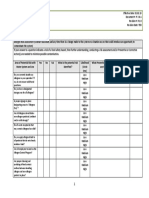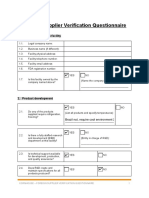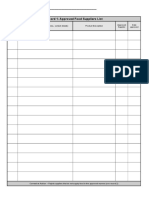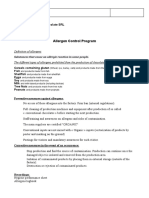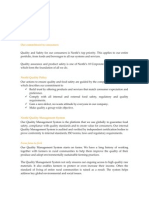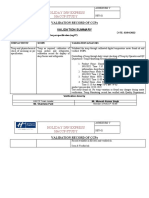0 ratings0% found this document useful (0 votes)
285 viewsFood Safety Rules - A3 Poster
Food Safety Rules - A3 Poster
Uploaded by
Bhavana BhattThe document provides food safety rules around keeping food hot, cold, clean, uncontaminated, and allergen safe. It discusses temperature requirements for storing and cooking food, separating raw and cooked foods, cleaning equipment, and identifying allergens.
Copyright:
© All Rights Reserved
Available Formats
Download as PDF, TXT or read online from Scribd
Food Safety Rules - A3 Poster
Food Safety Rules - A3 Poster
Uploaded by
Bhavana Bhatt0 ratings0% found this document useful (0 votes)
285 views1 pageThe document provides food safety rules around keeping food hot, cold, clean, uncontaminated, and allergen safe. It discusses temperature requirements for storing and cooking food, separating raw and cooked foods, cleaning equipment, and identifying allergens.
Original Description:
Food safety
Copyright
© © All Rights Reserved
Available Formats
PDF, TXT or read online from Scribd
Share this document
Did you find this document useful?
Is this content inappropriate?
The document provides food safety rules around keeping food hot, cold, clean, uncontaminated, and allergen safe. It discusses temperature requirements for storing and cooking food, separating raw and cooked foods, cleaning equipment, and identifying allergens.
Copyright:
© All Rights Reserved
Available Formats
Download as PDF, TXT or read online from Scribd
Download as pdf or txt
0 ratings0% found this document useful (0 votes)
285 views1 pageFood Safety Rules - A3 Poster
Food Safety Rules - A3 Poster
Uploaded by
Bhavana BhattThe document provides food safety rules around keeping food hot, cold, clean, uncontaminated, and allergen safe. It discusses temperature requirements for storing and cooking food, separating raw and cooked foods, cleaning equipment, and identifying allergens.
Copyright:
© All Rights Reserved
Available Formats
Download as PDF, TXT or read online from Scribd
Download as pdf or txt
You are on page 1of 1
Food safety rules
Keep it hot Keep it cold Keep it clean
• Use a thermometer to make • Cold food must be 5 °C • Use clean, sanitised and dry
sure foods are thoroughly or colder. cutting boards, equipment
cooked and the centre • Frozen food must be and utensils.
reaches 75 °C. frozen hard. • Clean and rinse wiping cloths
• Hot food must be kept • Check the temperature of after each use, and change
at 60 °C or hotter. fridges and cold storage them frequently.
• Check that only clear juices run from thoroughly areas regularly. • Wash and dry your hands thoroughly
cooked minced meat, poultry, chicken or rolled roasts. and regularly.
Keep it uncontaminated Keep it quick Keep it allergen safe
• Keep raw food separate from • Limit the time that high-risk • Identify allergens and label or
cooked or ready-to-eat food. food is in the temperature name them in foods on your
• Use separate utensils danger zone (5 °-60 °C) and menu or display.
and cutting boards when return to the refrigerator • Use and store foods known to
preparing raw and cooked during delays. contain allergens in a way that
or ready-to-eat food. • Large portions of food take prevents them contaminating
• Thaw food in your fridge, away from, longer to cool. Divide large portions other foods.
and below, cooked or ready-to-eat food. into smaller batches before cooling. • Train staff in food allergen risks,
• If food is kept within the temperature danger zone management and communication.
for a total time of 4 hours or more, throw it out.
Don't let your
food turn nasty www.betterhealth.vic.gov.au www2.health.vic.gov.au/public-health/food-safety
Authorised and published by the Victorian Government, 1 Treasury Place, Melbourne. © State of Victoria, February 2017.
Printed by Mercedes Waratah Digital, Port Melbourne (1612005)
You might also like
- Food Safety AuditingDocument32 pagesFood Safety AuditingPandan TimurNo ratings yet
- Botnet BibleDocument89 pagesBotnet BibleGUy FawkesNo ratings yet
- FMCB - HACCP Yoghurt PDFDocument10 pagesFMCB - HACCP Yoghurt PDFEdelin Nilsa PutriNo ratings yet
- Basic Introduction To Food HygieneDocument24 pagesBasic Introduction To Food HygieneHas platiniumNo ratings yet
- SQFI Guidance RE: 2.8.3 Allergen Cleaning and Sanitation PracticesDocument6 pagesSQFI Guidance RE: 2.8.3 Allergen Cleaning and Sanitation PracticesRene Bonilla LanderosNo ratings yet
- Storage Food Check List: Dry Goods YES NO CommentsDocument1 pageStorage Food Check List: Dry Goods YES NO CommentsAliNo ratings yet
- Transport: I Design & FacilitiesDocument2 pagesTransport: I Design & Facilitiesmnegm2890100% (1)
- 253451B Towable Backhoe 100201 PDFDocument40 pages253451B Towable Backhoe 100201 PDFПавел Ангелов100% (1)
- Food Allergen Management TrainingDocument31 pagesFood Allergen Management Trainingranjan sahaNo ratings yet
- Allergen Risk AssessmentDocument1 pageAllergen Risk Assessmentevillalobos9672No ratings yet
- Using and Calibrating ThermometersDocument3 pagesUsing and Calibrating ThermometersSaravana KumarNo ratings yet
- Nescafe Greenblend 100gx6Document2 pagesNescafe Greenblend 100gx6Dexter John MolinaNo ratings yet
- Food Safety Management System 1721277130Document33 pagesFood Safety Management System 1721277130Niaz KhanNo ratings yet
- Food Safety PDFDocument11 pagesFood Safety PDFMaria AnnieskaNo ratings yet
- Foreign Supplier Verification QuestionnaireDocument11 pagesForeign Supplier Verification QuestionnaireWilliams CastroNo ratings yet
- Allergen ControlDocument20 pagesAllergen Controlmedtaher missaoui100% (1)
- Internal Training of Record Keeping and Monitoring CCPDocument23 pagesInternal Training of Record Keeping and Monitoring CCPHas platiniumNo ratings yet
- Emergency PreparednessDocument14 pagesEmergency PreparednessV Subramanyam QCNo ratings yet
- EXP 3 DesignDocument52 pagesEXP 3 DesignnasuhaNo ratings yet
- Food Safety Management SystemDocument36 pagesFood Safety Management SystemTony BejuNo ratings yet
- Model FoodSec Plan ProcessingDocument23 pagesModel FoodSec Plan ProcessingJorge Gregorio SeguraNo ratings yet
- Withdrawal ManualDocument47 pagesWithdrawal Manualatvenu16160No ratings yet
- Food Safety Management System BRCS GSDocument47 pagesFood Safety Management System BRCS GSwindy hartonoNo ratings yet
- Critical Elements For EMPDocument54 pagesCritical Elements For EMPGaganpreet KaurNo ratings yet
- Allergen Control Program - EnglishDocument1 pageAllergen Control Program - EnglishOrlando Clar Ralaisoa100% (1)
- Foreign Object PolicyDocument1 pageForeign Object PolicykhNo ratings yet
- FSSAI Vaccination Form - Tybar 2.5mlDocument2 pagesFSSAI Vaccination Form - Tybar 2.5mlanandsivNo ratings yet
- NestléDocument2 pagesNestléMariana DíazNo ratings yet
- CXG - 069e Guideline For The Validation of Food Safety Control MeasuresDocument10 pagesCXG - 069e Guideline For The Validation of Food Safety Control MeasuresYêu Thời Trang SophieParis100% (1)
- Clause Requirements: Interpretation Food Safety CultureDocument2 pagesClause Requirements: Interpretation Food Safety CultureMario HaimovichNo ratings yet
- Quality Control A Model Program For The Food IndustryDocument12 pagesQuality Control A Model Program For The Food IndustryJohn Henry WellsNo ratings yet
- FSMS RequirementsDocument20 pagesFSMS Requirementsshahid154205No ratings yet
- Guidance For Allergen Management and TestingDocument13 pagesGuidance For Allergen Management and TestingVasil TsonkovNo ratings yet
- Product SpecificationsDocument1 pageProduct SpecificationsMichael LandryNo ratings yet
- Quality Food Safety Policy March 2019Document2 pagesQuality Food Safety Policy March 2019Cristina NicoletaNo ratings yet
- 5 - Peanut Allergy Awareness QuizDocument1 page5 - Peanut Allergy Awareness QuizRahul Singh Panwar0% (1)
- Sensory Evaluation of TunaDocument23 pagesSensory Evaluation of TunaRylNo ratings yet
- Food AdulterationDocument13 pagesFood AdulterationNavita MapariNo ratings yet
- 2.5 FSSC 22000 Additional Requirements: Management of Services and Purchased MaterialsDocument5 pages2.5 FSSC 22000 Additional Requirements: Management of Services and Purchased MaterialsWasim ArshadNo ratings yet
- Job Description - Food & Safety ManagerDocument3 pagesJob Description - Food & Safety ManagerAyoubELBakiriNo ratings yet
- QM 014 Purchasing, Orders and Verification of Purchased MaterialsDocument5 pagesQM 014 Purchasing, Orders and Verification of Purchased MaterialsFood Safety Poke & CoNo ratings yet
- Validation of CCPDocument2 pagesValidation of CCPpratishtha nirankariNo ratings yet
- Internal Audit Risk AssessmentDocument2 pagesInternal Audit Risk AssessmentkhNo ratings yet
- FSQ in Food Storage and Distribution PracticesDocument19 pagesFSQ in Food Storage and Distribution PracticesberiNo ratings yet
- Food Loss & Waste Reduction PolicyDocument1 pageFood Loss & Waste Reduction Policyraamshankar11No ratings yet
- NAHA HCS 01 Slaughtering Processing 2Document35 pagesNAHA HCS 01 Slaughtering Processing 2Fazlur DenisNo ratings yet
- Determining Control MeasuresDocument17 pagesDetermining Control MeasuresGaganpreet KaurNo ratings yet
- GMP Behavior RequirementsDocument5 pagesGMP Behavior RequirementsFrankMartinezNo ratings yet
- OSHA Exposure Incident FormDocument2 pagesOSHA Exposure Incident FormHeather Marie MathisNo ratings yet
- QS-4-025, Issue 01, HACCP TeamDocument4 pagesQS-4-025, Issue 01, HACCP Teamsajid waqas100% (1)
- Food Safety System Certification 22000: FSSC 22000 FSMA Addendum For Human FoodDocument22 pagesFood Safety System Certification 22000: FSSC 22000 FSMA Addendum For Human FoodAssane MomadeNo ratings yet
- Section A - Demographics and Work HistoryDocument5 pagesSection A - Demographics and Work HistoryKamonrat PangareanNo ratings yet
- Template Food Control PlanDocument122 pagesTemplate Food Control PlanOsama AdNo ratings yet
- TACCPDocument17 pagesTACCProbit Siddiki100% (1)
- Technical Datasheet Nutritional Info Organic Cocoa LiquorDocument2 pagesTechnical Datasheet Nutritional Info Organic Cocoa LiquorUsman QaiserNo ratings yet
- Hazard Identification Decision TreeDocument2 pagesHazard Identification Decision TreeDutch CharmingNo ratings yet
- HACCP Training Material VER 002 05.05.15Document20 pagesHACCP Training Material VER 002 05.05.15Departed MoonNo ratings yet
- 2019 QSAI Food Processing Quality (FPQ)Document35 pages2019 QSAI Food Processing Quality (FPQ)milka retamozoNo ratings yet
- Synthetic Food Grade Grease Synthetic Food Grade Grease: (NSF Certified (NSF Certified, Category H1, REGN NO. 147065)Document2 pagesSynthetic Food Grade Grease Synthetic Food Grade Grease: (NSF Certified (NSF Certified, Category H1, REGN NO. 147065)mayurghule19100% (1)
- FSMA-Foreign Supplier v5Document5 pagesFSMA-Foreign Supplier v5Hazel MorazanNo ratings yet
- Validation-Of - Microbiological-Control-MeasuresDocument40 pagesValidation-Of - Microbiological-Control-MeasuressomnitNo ratings yet
- Guilty - Trump Becomes First Former US President Convicted of Felony CrimesDocument6 pagesGuilty - Trump Becomes First Former US President Convicted of Felony CrimesバナナNo ratings yet
- Key Functions of An HR DepartmentDocument12 pagesKey Functions of An HR Departmentaiman MNo ratings yet
- 4 - RELATIVE CLAUSES EXERCISES (Extra Practice)Document2 pages4 - RELATIVE CLAUSES EXERCISES (Extra Practice)Name NameNo ratings yet
- Frick Pureoil: Optimize The Performance of Your Frick EquipmentDocument6 pagesFrick Pureoil: Optimize The Performance of Your Frick EquipmentFrio EspecializadoNo ratings yet
- ECON-UA 370 Quantitative Econ With Python: Lecture 1: IntroductionDocument15 pagesECON-UA 370 Quantitative Econ With Python: Lecture 1: Introductionagonza70No ratings yet
- Ijlaps Brochure (17.10.2022) 17h43 RKHKRHDocument2 pagesIjlaps Brochure (17.10.2022) 17h43 RKHKRHTrewx Trewx Wozniak HectopNo ratings yet
- General Specifications For Freeways and Toll Roads Final AugDocument552 pagesGeneral Specifications For Freeways and Toll Roads Final AugGen RicNo ratings yet
- Pex8619 Databook PDFDocument1,200 pagesPex8619 Databook PDFNiteshupaNo ratings yet
- Est 6924 From FESSA DISTRIBUTION 4152 PDFDocument1 pageEst 6924 From FESSA DISTRIBUTION 4152 PDFAhmad BayhakiNo ratings yet
- Topps Vs Upper Deck June 18 Court FilingDocument4 pagesTopps Vs Upper Deck June 18 Court FilingRipkenNo ratings yet
- Time TaDocument3 pagesTime TaAbhishekNo ratings yet
- Lean Manufacturing: ObjectiveDocument26 pagesLean Manufacturing: Objectivegokul sNo ratings yet
- DIGITCOM DVR Manual PDFDocument9 pagesDIGITCOM DVR Manual PDFAngel R TricaseNo ratings yet
- C Programming and Data Structures Lab ManualDocument275 pagesC Programming and Data Structures Lab ManualAnanth NathNo ratings yet
- CorelDRAW X5 Custom Keyboard ShortcutsDocument1 pageCorelDRAW X5 Custom Keyboard ShortcutsziediveNo ratings yet
- Identifying Customer NeedsDocument38 pagesIdentifying Customer NeedsPeriNo ratings yet
- Design and Implementation of A Gas Leakage Detector Using Wireless Data Acquisition System For Real Time Applications Using The Concept of IoTDocument3 pagesDesign and Implementation of A Gas Leakage Detector Using Wireless Data Acquisition System For Real Time Applications Using The Concept of IoTEditor IJRITCCNo ratings yet
- Ind DifferencesDocument6 pagesInd Differencesapi-3810976100% (2)
- Induction and Airflow PDFDocument4 pagesInduction and Airflow PDFmellon3duwenNo ratings yet
- Accident Investigation & Counter MeasuresDocument40 pagesAccident Investigation & Counter MeasuresabdelrahmanNo ratings yet
- Burj Khalifa - Construction and Quality Control: D.S. Rajendra PrasadDocument11 pagesBurj Khalifa - Construction and Quality Control: D.S. Rajendra PrasadAsif MahmoodNo ratings yet
- Sponsors of National Merit ScholarshipsDocument4 pagesSponsors of National Merit ScholarshipsSamarth KNo ratings yet
- Anime: Jump To Navigation Jump To SearchDocument3 pagesAnime: Jump To Navigation Jump To SearchFeb PiolNo ratings yet
- Sesi - 07A - Seismic Processing - BasicDocument200 pagesSesi - 07A - Seismic Processing - BasicRidho Irsyad100% (1)
- ESAB 453ccDocument32 pagesESAB 453ccdavid bolivarNo ratings yet
- Module 4 - Research Methodology and DesignDocument223 pagesModule 4 - Research Methodology and Designkhairunnisa90No ratings yet
- 328) CGL Mains 2023 Maths Mock-16Document6 pages328) CGL Mains 2023 Maths Mock-16dalaljatin41No ratings yet
- Experiment No.2 Ohm's Law For Linear and Nonlinear Circuit: ObjectDocument6 pagesExperiment No.2 Ohm's Law For Linear and Nonlinear Circuit: ObjectBoss barkatNo ratings yet









